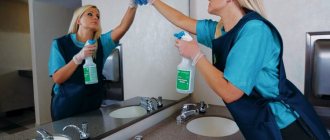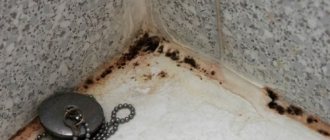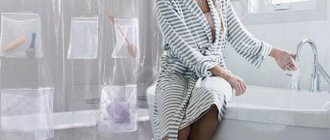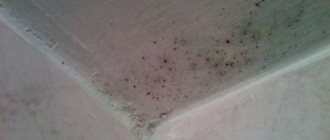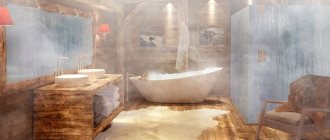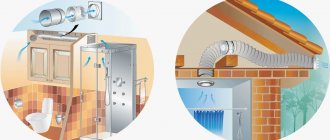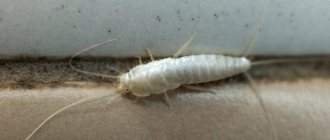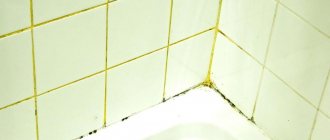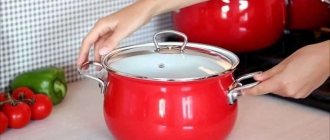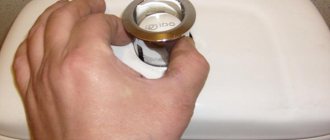The appearance of limescale in the bathroom is a problem that every housewife faces sooner or later. This happens due to the high content of mineral salts in the water that we use daily. To effectively combat plaque, the bathroom cleaning process must be approached competently. When cleaning different surfaces, it is important to take into account the characteristics of each of them. The danger is that some coatings are very sensitive to aggressive cleaning components. Moreover, irreparable damage can be caused to surfaces if the choice of chemical is incorrect.
This article reveals the main secrets that you need to know in order to successfully remove plaque accumulated on walls, pipes, glass, chrome parts and enameled coatings over and over again. Find out them, and then your bathroom will confidently sparkle with cleanliness, and you will enjoy being in it. We also suggest that you familiarize yourself with a useful video clip that will help you visualize the entire process.
Causes and features of the formation of limescale
The culprit of lime deposits is considered to be tap water, or rather its chemical composition. The abundance of magnesium and calcium salts upon contact of water with the surface leads to the appearance of impurities, which over time calcify and turn into water stone. This kind of education
- has an off-white tint, to which yellowness is added;
- does not dissolve in water;
- almost impossible to remove without special means;
- may damage the coating.
A factor contributing to calcification are fatty deposits, which are washed off from the skin and act as a binder for salt particles.
How to remove soap scum
This is a sediment from the evaporation products of shower gels, shampoos, and regular soap. It starts out as a thin, invisible film, but over time visibly covers the tile. The color of the coating becomes faded and dull. It’s easy to remove a very small layer of plaque, but a long absence of cleaning is a reason to work hard.
It is impossible to avoid the appearance of a soap film, because all detergents evaporate upon contact with hot water. To prevent plaque buildup, wipe the coating dry after each water treatment.
Method No. 1
Dishwashing detergent will do. Dissolve it in warm water until foamy. Apply it to the tiles and leave for 20-30 minutes. It is important to treat the entire surface and make sure that the product dissolves plaque. If necessary, repeat the procedure. The detergent is washed off with regular warm water. It is advisable to wipe the tiles dry.
Method No. 2
You can prepare an aggressive solution from vinegar, ammonia and soda. The proportions are given for 1.5 liters of water, we take parts in tablespoons: 7: 4: 5 (soda: vinegar: ammonia). It is most convenient to spray. Leave for 30-40 minutes. on the tiles, then wash thoroughly.
Plaque removers
Experienced housewives have many substances in their arsenal to combat lime deposits. Traditionally, they are divided into special and folk remedies.
Specialized means
Household chemicals include a huge number of cleaners that allow you to clean different types of surfaces. These can be creams and gels, solutions and powders of varying degrees of effectiveness.
- Mister Muscle, an effective remedy for combating stone and rust on various types of coatings, including acrylic, cast iron, enamel and ceramics. Available in gel or spray form. The first is applied with a sponge, the second is sprayed over the affected surface. After a few minutes, wash off with water.
- Silite, another universal preparation with a small amount of oxalic acid. This element increases efficiency but requires caution when used on acrylic surfaces. The peculiarities of the composition make it possible not only to remove calcification, but also to create a protective film that prevents its re-formation.
- Domestos, one of the most effective options for household chemicals, copes well with the effects of calcification and rust stains. Thanks to its thick consistency, it adheres well to vertical walls. Has an antibacterial effect. Not recommended for acrylic.
- SanClean, a mild version of the cleaner, easily copes with stone, allows you to remove layers of fat, rust, and creates a protective film on the treated areas. It has two forms: gel and solution in a container with a spray bottle. A tangible advantage of this composition is the pleasant aroma and noticeable refreshing effect after use.
The method of application of all options is approximately the same. The selected preparation is applied with a sponge or sprayed over the coating. After a certain time, from several minutes to several hours, it is washed off with water. More detailed instructions for use are usually contained on the container labels.
Folk remedies
For those who prefer to save on detergent, homemade cleaners are the preferred option. They are cheaper and often no less effective than factory-made competitors.
- Citric acid is one of the popular substances that allows you to get rid of plaque in the initial stage of its formation. The application procedure is simple and does not require special preparation. Alternatively, a certain amount of a crystal-like substance is poured onto a sponge, and the calcified areas are treated and washed with water.
- Vinegar is another product that is often used as a viable option. Increased acidity has a destructive effect on lime, allowing you to remove the stone quickly, efficiently and without negative consequences for the glossy surface. The easiest way is to pour the solution into a container with a spray bottle, treat the dirt with it, brush it, wait up to 10 minutes and thoroughly wash the surface with running water.
- Baking soda remains a popular cleanser option. From it you can prepare a solution of a tablespoon per liter of water or apply the powder to a sponge. Otherwise, the procedure does not differ from that described above.
The listed substances can be used independently or combined in various versions and proportions, taking into account the characteristics of the coating.
Best remover
When answering the question, what is the best solution for removing plaque, we suggest focusing on the following factors:
- efficiency;
- versatility (how suitable it is for cleaning certain surfaces);
- availability and cost;
- safety of use.
It is safe to say that the most universal and, probably, the best assistant in the process of cleaning the bathroom from plaque left by hard water is ordinary table vinegar.
This is interesting: vinegar is a “folk” remedy for limescale in the bathroom, which effectively copes with stains left on any surface: tiles, tiles, in the seams between them, acrylic, glass and enamel. Using this method, you can also remove plaque from faucets and other chrome surfaces.
The sequence of cleaning actions is standard.
- Pour a 6% vinegar solution into a spray bottle and treat problem areas in the bathroom with it.
- Let the substance act for 5-7 minutes.
- Thoroughly rinse the areas previously treated with vinegar and remove any drips (if any).
- Wipe the surfaces dry with a microfiber cloth.
Considering that the proposed product is widely available, has a low price and is absolutely safe for such household use, it can safely be called the best for most of us in the fight against limescale.
Cleaning cast iron and enamel bathtubs
When choosing a cleaner for a cast iron bathtub or its analogue with an enamel coating, you need to take into account the abrasive properties of the substance:
- cheap household chemicals can effectively remove lime deposits, but they usually contain a lot of abrasive substances that leave scratches invisible to the eye, accelerating the formation of stone;
- the preferred option for such coatings are products that contain inhibitors; they destroy the stone without damaging the enamel;
- Formulations with nitric or sulfuric acids are not recommended for everyday use; their single use against old stone is allowed;
The best choice for cleaning is considered to be cleaners based on surfactants; they remove plaque relatively easily without harming the base.
Cleaning acrylic bathtubs
Cleaning an acrylic bathtub from limescale at an early stage of its occurrence is not difficult. Coatings of this type can be easily cleaned with most liquid preparations. But there are certain nuances:
- aggressive substances such as ammonia, acetone or bleach will, of course, clean the surface, but irreparable damage will be caused to the sensitive coating;
- From the entire list of cleaners, it is advisable to choose those specifically designed for acrylic bathtubs, with a corresponding mark on the label;
- To avoid heavy deposits, regular cleaning is recommended; once a week will be enough to keep your plumbing fixtures clean and attractive.
If for some reason special chemicals are not available, you can use a homemade recipe with a delicate effect. The bath is filled with water at a temperature of about 25°C, 6% table vinegar (0.5 l) or citric acid (bag) is added and left overnight. In the morning, the solution is drained, everything is thoroughly washed and dried with a dry soft cloth.
How to remove limescale in the bathroom
As already mentioned, differences in the structure of certain surfaces require the presence of a wide arsenal of detergents in the household.
Let's take a closer look at the nuances of washing a bathtub and sink.
If the acrylic surface has turned yellow or lime deposits have appeared in some areas of it, they must be removed using special chemicals produced specifically for plastic. Typically, the manufacturer of plumbing fixtures indicates in the instructions which cleaning compounds can provide the bathtub with the most gentle care. If the contamination is not so significant, then regular dishwashing detergent or shower gel will help give the surface shine and freshness.
Caution : Do not use hard metal sponges or powdered cleaning agents for an acrylic bathtub. They can severely scratch delicate materials. It is also unacceptable to use detergent mixtures that contain aggressive acids, alkalis, ammonia or chlorine.
It is recommended to clean the enameled coating of a cast iron or steel bathtub from limescale without using store-bought compounds. A simple soap solution will do the job perfectly. The main condition is to wash the bath regularly. You need to pay attention to cleaning the container at least 1-2 times a week.
Advice : the best protection against limescale is preventing its occurrence. In order for cast iron plumbing to please you with cleanliness for as long as possible, you need to take care of its dryness. Just after each bath, remove moisture from the walls and bottom of the bath with a soft cloth.
To wash ceramics (the sink is most often made from it), it is important that the product itself is liquid or gel-like, since abrasive components can damage the surface. You can purchase a special gentle detergent composition at any household chemicals store.
The sequence of actions for cleaning the surface is as follows.
- Apply a small amount of the substance to a sponge, treat problem areas, and leave the product to act for a few minutes.
- Rinse off the chemicals with water and remove excess moisture.
- Ready! Your sink looks like new!
Grated laundry soap dissolved in hot water can easily remove plaque from faucets, shower faucets, showers and other chrome-plated surfaces. All you need to do to clean is to rub the contaminated elements with force, then rinse off the solution with hot water and blot dry with a soft cloth. A better effect can be achieved by adding another half teaspoon of regular soda to the solution.
The chrome faucet for the shower stall can be easily cleaned with special compounds that are widely available in the store: “Silit”, “Komet” and others. Remember that powders can scratch the glossy surface of the device, so choose cream or gel products.
Don’t forget to take care of such an accessory as a bathroom curtain. It protects the rest of the room from splashes, but at the same time it can become dirty, becoming covered with plaque and black spots of mold. This product can be machine washed, and in case of stubborn stains, pre-soak it in warm water with powder and bleach.
Removing old plaque and “water stone”
To remove strong, old contaminants, gentle measures are indispensable. In this case, you will have to take a risk and use potent compounds. An option for such a cleaner could be a preparation based on whiteness:
- We reduce any cleaning powder to a paste using a small amount of water;
- add a tablespoon of white and two equal tablespoons of vinegar;
- using a spatula, carefully treat the areas affected by the stone and wait up to 20 minutes;
- Using a thick sponge with a soft action, we clean off and completely wash off the remaining substances along with the lime;
- The last stage is drying the surface with a soft, dry cloth.
An alternative recipe with similar cleaning properties involves using ammonia diluted with water in equal proportions. You will need to add tbsp to the resulting solution. spoon of citric acid.
What products are used to get rid of plaque?
You can find out how to remove plaque in the bathroom from the operating instructions for such a plumbing structure, which can be made of different materials.
Their cleaning may require the use of abrasive or delicate compounds, instrumental or manual processing, which is associated with maintaining the physical and operational properties of plumbing fixtures.
To completely and quickly remove darkening and visual stains, you can use various products, available in a wide variety on the modern market:
- biologically active products with a natural base, harmless to human health;
- chemical preparations based on alkaline and ammonia compounds with increased effect.
Experts recommend drawing up a cleaning and cleaning schedule, which can be implemented by periodically cleaning surfaces with synthetic chemicals and various compounds.
You can supplement your bathroom cleaning and care complex with the use of natural products and compositions made from soda and ammonia, and other homemade solutions that are highly effective.
Useful tips and recommendations
It's better not to clean
Indiscriminate choice of cleaner can result in damage to even the most durable coating. Therefore, you should always remember the list of substances that are not recommended for use:
- preparations containing aggressive acids;
- powders with pronounced abrasive properties;
- highly concentrated products.
The latter must first be diluted in the proportions recommended by the manufacturer. In addition to carefully choosing a cleaning product, you need to take the search for brushes and scrapers seriously. They should not be made of rough material, for example, metal products should be completely excluded. The best choice is sponges, brushes, scrapers made of elastic synthetic materials.
How to take care of your bathroom and prevent limescale from appearing
We must never forget that the best way to combat pollution, including lime deposits, is their prevention. There are several simple ways to prevent calcification:
- mandatory rinsing after each use;
- regular cleaning at least once a week;
- Soak laundry and things only in separate containers.
The installation of filters should be added to this list of preventive measures. This is more expensive, but the costs will be justified by the cleanliness and safety of the plumbing. In the future, you won’t have to spend much more money on its restoration.
scum.su
Causes of stains in the bathtub and their nature
A bathtub is a household item that requires constant care. Keeping it perfectly clean is especially difficult for families with small children and animals. This contingent finds dirt everywhere. Resin, gasoline, paint and glue will never be ignored by inquisitive kids and pets. In addition, stains on the bathtub appear with sad regularity due to:
- long-term use: over time, the coating wears out, and dirt is absorbed deeper, and removing it is more problematic;
- improper use: for soaking mushrooms or vegetables, washing dirty shoes and carpets, draining residual chemicals and dyes;
- low quality of water used. This is a major problem in most populated areas. Before being supplied to the population, it undergoes chemical purification, and there is simply no crystal clear water in today’s water supply systems. Substances used for cleansing will certainly leave an unpleasant residue;
- old worn-out water pipes, which are the main cause of rust on the walls of the bathtub.
We must not forget about natural organic pollutants that leave traces after bathing people and pets. After each use, the bathtub must be washed with soapy water and rinsed with water. Then the dirt will not eat into the coating and destroy it.
Main types of pollution
You can spend a lot of time and effort on cleaning and not achieve results. A product purchased on the advice of a neighbor or a store clerk will be ineffective if used without following the instructions.
It is important to determine the nature and type of contamination in order to eliminate it completely without damaging the coating . Otherwise, the smudges will remain, and the bath will become rough and it will be unpleasant to take water procedures in it.
Rust
A high iron content in tap water will definitely stain the surface with “saffron milk caps”.
If the cause of rust is rotten pipes, a worn-out faucet or a dripping faucet, then they need to be replaced. Otherwise the struggle will be useless. Stores offer various products for removing red stains from plumbing surfaces. Many of them are very aggressive and can harm both the container itself and the people using it. Rust is iron oxide, neutralized by acids and alkalis. Keeping in mind that you still have to bathe in the bath, it is better to use only proven products.
Yellow plaque
The appearance of a yellow coating on the bathtub indicates poor quality of the water and the products used to clean it. A yellowed bathtub is a consequence of the high presence of metal and chlorine molecules in the water. You can avoid this problem by washing the bathtub after each use and wiping it dry.
Limescale and waterstone
When choosing a remedy to solve this problem, you should take into account the surface material of the bath itself. Of the universal methods, the most effective will be the following:
- 3 tbsp. dilute soda with water until a paste forms.
- Distribute the mixture over the surface.
- Wait until the paste dries.
- Pour 9% vinegar into a spray bottle and spray on the affected areas.
- Apply with a soft sponge and rinse with water.
The cause of such formations is considered to be water hardness. To avoid them, it is recommended not to use the bath for long soakings and after each use, wipe dry with a piece of rags or a towel.
Mold
Mold is a fungus that loves moisture.
To eliminate it, first of all, it is necessary to establish ventilation, clean the shafts, avoid stagnation of water and ventilate the room more often. Moldy marks on the bathtub can be removed with tea tree oil, this will serve as both treatment and prevention. The product will need to be diluted with water in a ratio of 1:50, applied to the affected surfaces and wiped with a damp cloth after a day. To get rid of mold forever, you should eliminate all possible sources of dampness: promptly wipe dry spilled water, replace leaking taps and pipes, and avoid condensation accumulation.
Remains of sealant
A useful sealant that accidentally gets on the walls of a bathtub can significantly spoil its appearance. It must be removed fresh, without waiting for it to harden. Otherwise, mechanical cleaning is indispensable, and it is not suitable for all coatings.
Household chemicals for bathtub cleaning
Plumbing cannot be perfectly clean without regular antimicrobial and antibacterial treatment. You can't do without household chemicals here. You should resort to such measures regularly, but without fanaticism. Chemicals can harm both the coating of the container and the bathers themselves. It is better to use proven products, being sure that they will not cause irritation to the skin of family members.
Whiteness in various forms
Whiteness, due to its chlorine content, copes well with dirt, bacteria and unpleasant odors. The disadvantage of this product is that it is aggressive; it is not suitable for all surfaces and can cause a negative reaction in allergy sufferers, children and pets.
In small doses, Whiteness is quite harmless.
To clean and disinfect, you need to pour a bottle of liquid into a bathtub filled with cool water and leave it for several hours with the door to the room tightly closed (preferably overnight). In the morning, after draining the water, wash with soapy water and ventilate the room. You should work with the product wearing a respirator and rubber gloves.
Mister Muscle for baths
An excellent product for removing soap scum and dirt “Mr.Muscle Expert 5 in 1”. The convenient spray nozzle allows you to distribute the cleaning liquid evenly and targetedly, even in hard-to-reach places. This all-rounder easily copes with:
- soap scum and stains;
- microbes;
- unpleasant odor and mustiness;
- stubborn dirt.
"Mr.Muscle Expert 5 in 1" is suitable for any surface and is easy to use. It must be applied to a dirty surface, left for 10 minutes, wiped with a dry cloth and rinsed with water. Taps, mixers and bathtub will sparkle with cleanliness.
Comet-gel for plumbing
Comet gel is suitable for removing soap and lime deposits, grease stains, rust and deep dirt. Destroys 99% of germs and adds shine, but is not suitable for all coatings. Acrylic and ceramics can be significantly damaged by this aggressive agent, and not all enamels are resistant to it.
If you can’t deal with stains with gentle products, then you should test the surface of your bathtub for resistance. To do this, apply a small amount of gel to a small and inconspicuous area (side or near the drain hole). It is better to remove shallowly ingrained dirt with a diluted product.
Cif brand products
To clean the bathtub, Cif in the form of a cream or spray is preferable.
The advantages include effective removal of contaminants of various nature and water-repellent effect, which allows you to maintain a neat appearance of plumbing fixtures without streaks for a long time. Disadvantages: the substance is not recommended for use on acrylic and damaged coatings; leave it on the enamel for more than a minute. Suitable for chrome, earthenware and porcelain surfaces. Like any household chemicals, it is recommended to use it with protection of the skin and respiratory tract. Cif brand products are more suitable for regular cleaning; they are rather weak for old and deeply ingrained dirt.
Sanox cleaner
Sanox products contain hydrochloric acid and can destroy fragile coatings, but despite this aggression, they do not cope very well with stains. The price of the products is attractive and fully corresponds to the quality.
Experienced housewives do not recommend cleaning their bathtubs, thereby giving rough chemicals access to their body. Even after numerous rinses, caustic substances remain on the surface. A product that can destroy enamel cannot be safe for the skin, and savings are inappropriate here.
Safe eco-product Frosch
The European product from the Frosch brand is suitable for almost all surfaces and is very effective. Available in a bottle with a spray, it actively fights red spots, soap stains and limescale.
The eco-product is safe for both enamels and health. Has a pleasant aroma. Returns bathtubs, taps and mixers to their original shine. Simple and easy to use: the product is sprayed on the surface and removed with a damp cloth after 10 minutes. If the plaque and yellow stains have not disappeared completely, the procedure must be repeated.
How to remove limescale on tiles
The most obvious option is to go to the store and buy a composition with the necessary components for washing ceramic tiles and tiles. Available in the form of a spray or a bottle of gel, the product will effectively cope with various types of contaminants.
Fortunately, manufacturers of household chemicals offer a wide range of chemicals. You can choose from these common options:
- Domestos;
- Comet;
- Mister Muscle;
- Silit;
- San Klin;
- Sif et al.
The most suitable remedy for this purpose is a universal one. It is applicable both for eliminating rusty stains and for removing plaque, and can also prevent the appearance of mold.
Important : to prevent active ingredients from getting on your hands, use rubber gloves when cleaning. You also need to make sure that the concentrate does not get on acrylic and chrome surfaces. They are very sensitive to chemicals.
Traditional methods of cleaning a bathtub
Housewives are increasingly abandoning specialized chemicals, preferring natural home remedies. Traditional methods of bath cleansing have been tested for years, are safe, low-cost, but quite effective. Each of them is good for a specific surface. Do not forget that enamel is not friendly with concentrated acids, and acrylic is not friendly with alcohol solutions.
Baking Soda with Vinegar and Bleach
Baking soda has excellent cleaning properties. It is not recommended to use it dry on bathtub surfaces; although it is soft, it is still an abrasive. When starting work, you should put on rubber gloves, and then:
- Dilute baking soda with water until it becomes mushy.
- Distribute the mixture evenly along the walls of the bath.
- Leave for 10 minutes.
- Mix a packet of bleach with table vinegar to the same consistency.
- Apply a thin layer over the baking soda.
- After 40 minutes, rinse with warm water.
As a result, even an old surface will sparkle with cleanliness.
Lemon acid
A solution of citric acid can deal with unpleasant old yellowness. Dilute 2 tbsp in 0.5 liters of warm water. powder until completely dissolved (no grains should remain). Apply the liquid to the coating with a soft sponge and rinse with plenty of water after 20 minutes. After treatment, wipe the acrylic surface with a rag soaked in a soda solution. This will completely neutralize acid residues and prevent destruction of the coating.
Borax with lemon juice
Borax is sodium tetraborate, used in industry, for soldering or in photography, as a developer. To remove rust, a mixture of Borax and lemon juice is indispensable. To prepare the cleaning paste, you need:
- Squeeze a quarter cup of juice from a fresh lemon.
- Add Borax to a paste-like consistency.
- To stir thoroughly.
- Apply directly to problem areas.
- Wait until completely dry.
Wash off with water, and then with soapy water. If the ingrained rust has not completely disappeared, repeat the treatment after a few days.
Cleaning powder paste
Powders in their pure form can leave scratches on the enamel, so it is better to use them as a paste. The mixture is prepared independently: combine 5g of cream of tartar crystals, 300g of any cleaning powder (preferably with a disinfectant effect) and 60ml of hydrogen peroxide in any sequence. The paste is applied pointwise to remove “saffron milk caps”. Its remains should be stored in a tightly closed container.
Ammonia and hydrogen peroxide
It is easy to prepare a solution to combat limescale. To do this you should:
- In a dry glass container, mix 100 ml of ammonia and 50 ml of hydrogen peroxide.
- Soak a piece of rag in this solution.
- Wipe dirty areas with it.
- Rinse off with warm water after 15-20 minutes.
- If there is a noticeable but insufficient effect, repeat after a few days.
Attention! This treatment is not suitable for acrylic bathtubs; ammonia can damage the coating.
Soda with washing powder
A mixture of washing powder and soda will help to clean the font from stubborn dirt. Mix 2 tbsp in a ceramic bowl. each ingredient with a glass of hot water. The product is used warm - distributed with a sponge over the entire surface. After 15-20 minutes, if the walls are heavily soiled, rub them with a sponge and rinse with water. Experienced housewives advise finishing the procedure by covering the surface with a cut of half a lemon - this will give a radiant shine.
Soda ash with laundry soap
A mixture of laundry soap and soda ash works well for various stains. Grated soap is mixed with soda in a 1:1 ratio. The composition is diluted with water to a thick paste, then applied to dirty areas. After an hour, the coating should be rubbed with a sponge or nylon brush and rinsed with water. You can also clean plastic panels and cabinets in the bathroom in the same way.
Trisodium phosphate and hydrogen peroxide
Another enemy of rust is a mixture of hydrogen peroxide with trisodium phosphate, diluted in warm water (4 tablespoons per 3 liters of water). After the powder has completely dissolved, gradually add 50 ml of peroxide and mix gently. Treat stains with a rag generously soaked in the solution and leave for 10-15 minutes, rub with a sponge or old toothbrush and rinse with water.
Oxalic acid
Technical oxalic acid diluted in water in a ratio of 1:10 will help get rid of red stains on acrylic products. The composition is applied to stains and washed off with water after an hour.
Table salt with wine vinegar
The following recipe will help you cope with the problem of yellow plaque:
- Heat 5 cups of wine vinegar in the microwave to 60 degrees.
- Mix in a non-metallic bowl with two tbsp. l. salt.
- Dip a sponge into this liquid and wipe the problem areas with it.
- After 30 minutes, rinse with water.
Attention: this method is not recommended if the yellowness was formed under the influence of dyes (for example, washing off hair dye). In this case, the acid can consolidate the effect, and it will be more difficult to get rid of it.
Laundry soap and ammonia
You can remove yellowness using the following composition:
- Dissolve grated laundry soap in a glass of warm water.
- Add 5 drops of ammonia.
- Stir until smooth.
- Spread with a sponge over the yellowed surface.
After 15-20 minutes, brush with a soft brush and rinse with plenty of water.
Vinegar
Table vinegar does an excellent job of removing yellow stains. You can use it this way:
- Take a little warm water into a container washed with soap.
- Pour 200 ml of vinegar into it.
- Dip an old sheet into water, soaking style.
- Drain the water and spread the sheet over the entire surface of the bath.
After 30-40 minutes, remove the sheet, wash the surface with soap and rinse with water. After this treatment, the coating will become white and shiny.
Methods for removing deposits
Before running to the store for chemical solutions, you can try to solve the problem with improvised means.
Substances for cleaning deposits in the bathroom are available to every housewife. But they need to be divided into groups, since not all compositions are suitable for different surfaces.
Tile
The most common method is using vinegar. A 6% composition is suitable. If essence is used, it is better to dilute it with water in equal proportions.
The liquid should be poured into a spray bottle and sprayed over the surfaces of the bathroom.
We pay special attention to places with limescale deposits. There is no need to use metal brushes for cleaning; just leave acetic acid on the walls for about half an hour, then rinse with clean water using a sponge.
A soap solution with the addition of ammonia helps get rid of layers well. Wipe the base of the bathtub with the mixture several times.
In hard-to-reach areas and heavily contaminated areas, allow time to react. Soft brushes are used for cleaning.
Please note that any powder contains abrasives; this is not the best choice for acrylic. It is optimal to eliminate deposits with gel-like mixtures. At the end, the walls are wiped dry.
The steam cleaner does an excellent job of removing deposits on ceramic tiles. But after cleaning it is better to check the seams. If exposure to a hot jet has damaged the sealant, it will need to be restored.
Bath
In this case, it all depends on what material the bowl is made of.
There are 2 popular materials for bowls:
- Acrylic coatings do not tolerate exposure to hot liquids or aggressive substances. You will have to give up cleaning plaque with ammonia, acetone, and soda. It is better to use citric acid and vinegar. To make the composition more effective, you can add dishwashing solution. This will help not only get rid of deposits, but also remove grease stains and rust.
- Cast iron hot tubs are not afraid of abrasive powders. Cleaning with soda is acceptable here. It is scattered over the base and slightly moistened, left overnight to dissolve the plaque. The old layer can be removed by adding ammonia and grated laundry soap. Then wipe the bowl with alcohol and dry it. Sulfuric and nitric acid are not suitable for cleaning the bathroom; these are solutions that remove deposits from the toilet.
Also interesting: The problem of condensation in the toilet cistern
Bleach or chlorine also helps remove deposits. If you use the product regularly, you will not have to take drastic measures.
Taps, shower head and fittings
As a rule, accessories are made of metal. It is easiest to remove plaque from such a surface, since deposits do not eat deep into the coating.
An excellent product is a mixture of soda, ammonia and glass cleaning solution. The prepared mass is applied to all elements, wrapped in plastic wrap, and left for at least 6 hours.
During this period, the substances dissolve heavy salts and transform the hard coating into a soft paste. After cleaning, all that remains is to remove the dirt with a sponge, rinse with water, and wipe until shiny.
Cheap Jacuzzi fittings and jets need to be unscrewed, as layers form in the holes. To avoid damaging plastic parts, use citric acid or vinegar in these places.
You can use hydrogen peroxide, but not in its pure form. It is diluted half with water.
Turpentine helps get rid of plaque well. Apply the substance to a rag, wipe the accessories, then rinse and dry.
Features of cleaning different types of bathtubs
When buying a bathtub, you need to be prepared to care for it properly. Each coating has its own characteristic features that cannot be ignored when cleaning.
Acrylic
Acrylic products require careful and regular cleaning. Not suitable for caring for them:
- powder and abrasive products;
- compositions with a high content of chlorine, acids and alcohol;
- emulsions based on ammonia, acetone, gasoline;
- hard metal brushes.
An excellent product for caring for such a bathtub is Acrylan, which copes with the most difficult stains and even after rinsing protects the surface for a long time.
Cast iron
Products made of cast iron are not so capricious. When caring for them, you should not use aggressive products with high concentrations of acids and chlorine. Powders and hard brushes can scratch the coating; it is with minor damage that destruction begins. No less destructive for cast iron bathtubs are contrasting temperature changes.
Old cast iron bath
There is no need to rush to get rid of your old cast iron bathtub. You can give it a second life using Domestos with chlorine or simple whiteness. First, you should rinse the bathtub with as hot water as possible (as if warming up the surface), then walk over the entire surface with a sponge generously soaked in one of the products. Leave for 15 minutes, then rub again with a sponge and rinse with warm water. To prevent streaks, wipe dry with a towel, and the bath will be as good as new.
Ceramic
Ceramics is an unpretentious material that is resistant to acids. Powders and metal brushes should not be used when caring for a ceramic bathtub. Gels, emulsions and pastes should be used no more than once every 14 days. For daily cleansing we recommend: soap solution, baking soda and lemon juice.
Any chips and scratches need restoration, otherwise the ceramics will collapse.
Wooden
A wooden bathtub looks original, but it requires careful cleaning and handling. Chlorine and abrasive cleaning agents can damage the varnish coating. The container must be washed and dried after each bath. This type of bath is not suitable for soaking or caring for animals. You need to clean a wooden bathtub with special products for varnished surfaces.
Stone, marble
Products made of stone and marble look noble and require appropriate care. For everyday cleaning, it is better to use soda, vinegar, and mustard. Once a month you need to treat with special products: Cooky Spray, Dec, Pramol, etc.
Quarilovaya
Quaril or quaril is a synthetic mixture of acrylic and quartz. This material is stable and unpretentious. To clean such a bath, any non-abrasive products are suitable: gels, pastes, soft brushes and traditional methods.
Copper
Copper and bronze models require special care. After each use, they need to be wiped dry and polished with wax at least once every six months. Copper surfaces must not be cleaned with harsh abrasives or acidic agents. Among specialized products, we recommend Ideal paste and Asidol emulsion. Folk remedies include a scrub made from chalk, water and ammonia. Mix all the ingredients to a paste, rub over the surface, rinse after a couple of minutes and wipe the bath with a dry towel.
Steel enameled
Sudden temperature changes, cleaning powders, concentrated acids and metal brushes are harmful to enamel. All other products are suitable for care. After cleaning, you can dip a slice of grapefruit in fine salt and wipe the walls of the bathtub - this will restore its radiant shine.
Antique bathtub
Such products consist of a metal body and an acrylic working surface. All chemicals and folk remedies suitable for acrylic are suitable for caring for an old bathtub. You can get rid of individual stains using toothpaste: apply and rub in a little with your finger, and then rinse with water along with the stain.
How to clean tiles
To clean the tiles in the bathroom from plaque, you need to take a warm soapy solution, a weak concentration of vinegar or ammonia. Rubber gloves are put on your hands. It is best to wash the tiles with a soft sponge or an old toothbrush, or a microfiber cloth.
The step by step process is as follows:
- First, the tiles are washed with a warm soapy solution using a microfiber cloth, movements begin from the bottom;
- Use a sponge dipped in vinegar or ammonia to wipe the soap solution;
- Next, the tile is wiped dry, movements begin from the top.
It is enough to devote half an hour a week to treating the tiles so that they do not lose their appearance and shine.
Removing other types of contaminants
In addition to the inevitable plaque, rust and yellowness, there are force majeure pollution. These include traces of hair dye, faded items during soaking, accidentally spilled medications, etc. Such problems require quick solutions and a competent approach.
How to clean a bathtub from potassium permanganate and brilliant green?
Stains from such concentrated solutions are difficult to remove. Measures must be taken to eliminate them quickly, before the caustic substance penetrates deep into the enamel.
Hydrogen peroxide, alcohol or lemon juice will help here. You can moisten a cotton pad in any of the products and stick it to the stained area. If the result is not satisfactory, we will call on liquid Vanish for laundry to help. It is harmless for coating, but dangerous for stains of varying complexity and nature.
How to clean a bathtub after renovation?
It is difficult to avoid stains on the bathtub during renovation. When carrying out work, the bowl should be covered with plastic wrap, but if this does not help, it’s also not a problem. White Spirit is suitable for removing paint stains; the main thing is not to wait for the stains to dry.
Cilit Bang can handle tile adhesive, but it is not recommended to keep it on the surface for more than a minute. Apply, rub with a soft brush and rinse immediately.
How to remove sealant?
The sealant is available in two types: based on neutral or acidic silicone (the latter has a distinct smell of vinegar). Any of them, when fresh, can be easily removed from any surface with a dry cloth. The situation is more complicated with a frozen mass, especially when it has penetrated into cracks or small holes.
In this case, neutral-based mixtures are moistened with acetone, gasoline or solvent, acidic ones with table vinegar. After 10 minutes, the residue is removed with a wooden spatula (from the cracks carefully with tweezers), then rubbed mechanically with a soapy sponge. Home and auto cosmetics stores offer special products for removing sealant (Antisilicone, Titanium Selena, etc.), but after using them, the bathtub should be thoroughly washed.
How to remove mold?
A solution prepared at home and absolutely safe will help defeat mold. In a spray bottle you need to mix 2 cups of water, 1 tsp. alcohol and 10-15 drops of tea tree essential oil. Seal with a stopper and shake. By spraying areas that are attractive to fungus with this liquid, you can say goodbye to mold forever.
Baby bath toys
Children love to play while bathing. But it is not always possible to dry rubber and plastic toys well from the inside. And sometimes we just forget about it.
Over time, an unpleasant odor and black spots of mold appear. Table or apple cider vinegar and a few drops of tea tree essential oil will help cope with this problem. The solution is poured into a basin and toys are placed in it for several hours. Then they are washed very thoroughly with cold water and wiped dry.
It is even better and safer for the health of children to carry out such treatment of toys as a preventative measure once every few months.
Bathtub cleaning tools and products – what should you not use to clean your bathtub?
When selecting equipment for cleaning the bathtub, it is necessary to take into account the characteristics of the coating and the nature of frequent contamination. Every housewife should have in her arsenal: baking soda and vinegar, sponges and nylon brushes, household chemicals that cannot harm the coating and the health of the household.
You should avoid using hard brushes and powders, and do not leave cleaning gels and pastes on for a long time without rinsing off. Toilet care products are also not suitable for cleaning the bathtub; they are too aggressive and concentrated.
Precautions when cleaning the bathtub
Beauty and purity require sacrifice, but one must never forget about safety. To ensure that cleaning does not harm your health, you need to follow a number of simple rules:
- Rubber gloves should be used when working with chemicals.
- If the cleaning product has a strong odor, you should protect your respiratory system with a respirator and keep windows and doors open.
- Any detergents should be thoroughly washed off with water and soap, otherwise water treatments will result in skin irritation.
- All cleaning products should be kept tightly closed and out of the reach of children and pets.
For people with hypersensitive skin and children, only non-aggressive, hypoallergenic plumbing care products are suitable.
Preventing dirt and plaque
As preventive measures, it is recommended to wash and wipe the bathtub after each use, not to keep metal objects (basins, buckets, etc.) in it, and to put the ventilation and plumbing systems in order.
It is better to keep all aggressive and dyeing substances in cabinets, away from the bathtub. Do not leave objects on the sides that can leave rust marks or scratches: machines and metal bottles with shaving foam, iron ladles and brushes, etc. All family members must follow these rules; fighting for cleanliness alone often ends in failure.

